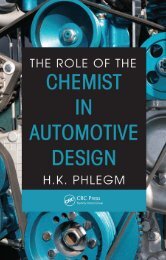Lightweight Electric/Hybrid Vehicle Design
Lightweight Electric/Hybrid Vehicle Design
Lightweight Electric/Hybrid Vehicle Design
You also want an ePaper? Increase the reach of your titles
YUMPU automatically turns print PDFs into web optimized ePapers that Google loves.
Current EV design approaches 19<br />
It is assumed that sealed batteries are to be used and consequently a battery voltage of 96 V<br />
was chosen to optimize the efficiency of motor and controller and particularly with an eye to<br />
controller cost. 200 V MOSFETS are near optimal at 100 V DC. A battery of 15 Ah 96 V<br />
weighs 40 kg (for comparison 24 V 60 Ah weighs 35 kg). In lead–acid 36 Wh/kg is achieved,<br />
while for comparison nickel hydride cells could offer 80 cells x 1.2 V x 25 Ah in a weight of 30<br />
kg. The motor has to deliver a torque of about 40 Nm maximum and consequently a pancaketype<br />
design was chosen. Induction motors were rejected due to low efficiency and large mass<br />
for this duty. The four practical contenders are: permanent magnet brushless DC; permanent<br />
magnet DC brush pancake motor; DC series motor or switched reluctance motor. A tabulated<br />
comparison at Fig. 1.17(a) compares results. As can be seen, the permanent magnet brushless<br />
DC motor is the optimum performer at the two key cruise conditions. It has been estimated that<br />
with regenerative braking and flat terrain, a range of 70 km could be achieved with a 96 V 15<br />
Ah lead–acid battery. The 25 Ah nickel hydride pack could give 120 km. However, 70 km is<br />
quite adequate for average daily use.<br />
1.3.6 SMALL CAR<br />
The small electric car is in the Mini or Fiat 500 class. Such a vehicle would weigh 750 kg and<br />
accelerate from 0 to 50 mph (80 km/h) in 12 seconds and have a range of 80 km with lead–acid<br />
batteries. The motor power would be 20 kW peak. As originally there were only aqueous batteries<br />
available, battery voltage was limited to 120 V DC by the tracking that took place across the<br />
terminals of the batteries due to electrolyte leakage. Two battery technologies were available:<br />
lead–acid and nickel–cadmium and vehicles were designed with efficiency = 25%, that is 188 kg<br />
of batteries if efficiency is expressed as battery mass/gross vehicle mass (for lead–acid 60 Ah 120<br />
V 7.2 kWh and for nickel–cadmium 85 Ah 120 V 9.9 kWh).<br />
Single quadrant MOSFET choppers were developed by Curtis and others to supply DC brushed<br />
series motors. The main advantage of this system was low cost (for example, lead–acid battery<br />
£900 in 1996; quadrant chopper £500; motor DC series £750). However, the apparent cheapness<br />
of this system is deceptive because: (a) fitting regeneration can raise the battery voltage to 150 V<br />
– an unsustainable level for some choppers – consequently friction braking was often used; (b) a<br />
separate battery charger was required. More recently sealed battery systems have become available<br />
and batteries of around 200 V are possible in two technologies, lead–acid foil and nickel hydride.<br />
These batteries are used with 600 V IGBT transistors which can operate at voltages up to 350 V<br />
DC. Battery capacity becomes limited if other services such as cabin temperature control/lighting/<br />
battery thermal management are taken into consideration. A small engine driven generator<br />
transforms this problem and it is perhaps worth noting Honda have achieved full CARB approval<br />
for their small lean burn carburettor engines with the discovery that needle jet alignment is critical<br />
to emissions control and negates the need for catalytic converters.<br />
All motor technologies are viable at 196 V; however, the practical consideration is that inverters<br />
are more costly than choppers which accounts for the popularity of DC brushed motors/choppers.<br />
To counteract the inverter cost premium, the electronically commutated machines have been<br />
designed for 12 000 rpm, to reduce the motor torque (DC brush machine 20 kW at 5000 rpm;<br />
other types 20 kW at 12 000 rpm). Another benefit of the higher transistor voltage capability is<br />
that the inverters/choppers can function as battery chargers direct off 220/240 V without additional<br />
equipment. High rate charging is possible where the supply permits. All electronically commutated<br />
machines provide regeneration. The motor comparison is tabulated at Fig. 1.17(b). All the machines<br />
deliver constant power (20 kW) over a 4:1 speed range, making gear changing unnecessary. The<br />
induction/brushless motors are assumed to use vector control.







